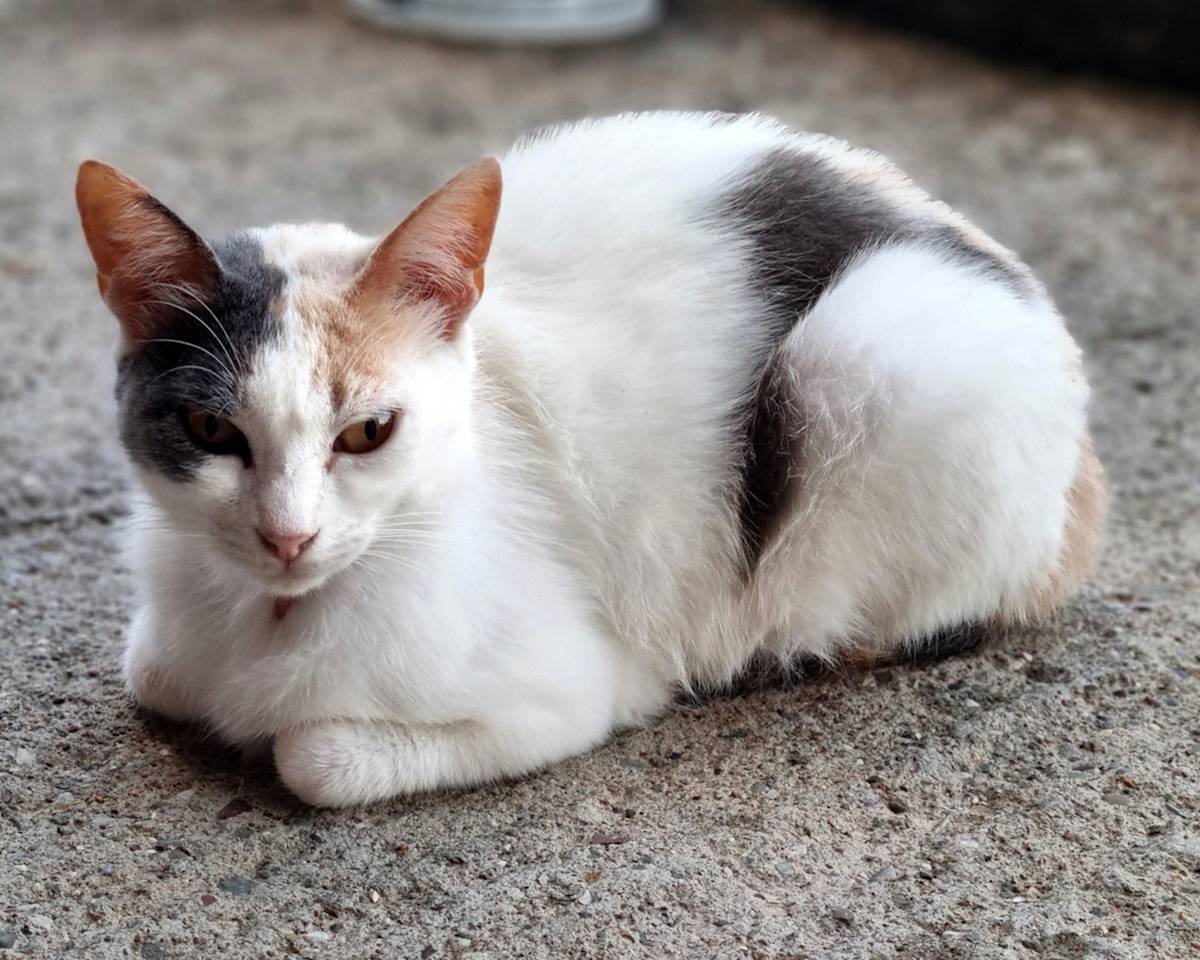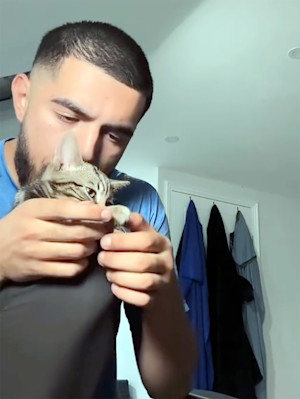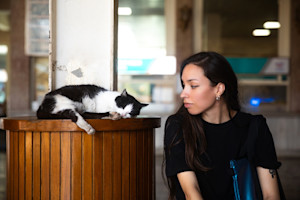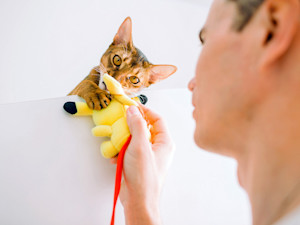Why Cats Can’t Resist Concrete
Your cat + concrete = true love. Who knew?

Share Article
If you’ve been on TikTok recently, you’ve probably seen cats on concrete slabs writhing around in ecstasy. Devoted pet parents are hauling home paving stones, and their indoor cats are obsessed. What started as a hack for former street cats has gone viral, becoming this summer’s breakout cat enrichment idea. Whether your companion is a rescue who once roamed the city pavements or a pampered purebred who’s never set foot outdoors, cats across the board seem to love lounging on solid concrete slabs.
Here’s the thing – as a cat behaviourist, I get it. I’m not usually a fan of viral trends. Many cause significant fear, anxiety and stress for the cats involved (think the “spinning challenge”, “breading”, and the infamous “cats vs tinfoil”). But this one? If introduced thoughtfully, it could be a genuine win for your cat.
So, let’s talk about why a humble concrete slab might just be your cat’s favourite piece of furniture.
The science behind cats’ concrete obsession
Strange as it may seem, a love of concrete isn’t random. From a behavioural science perspective, this trend taps into several core feline needs – physical, sensory, and emotional.
Temperature regulation and thermal comfort
A cat’s normal body temperature is slightly hotter than a human’s – between 38.1 to 39.2C (100.6 to 102.6F). This makes them more sensitive to ambient temperature shifts and more motivated to find surfaces that help regulate their temperature.
Add to that their ancestry. As descendants of the desert-dwelling African wildcat, they are designed to thrive in hot, dry climates, where staying cool during the day and warm at night often involves resting on rocks, bare earth and other natural surfaces that remain cool or hold heat, depending on the time of day.
Concrete mimics this natural environment surprisingly well. Its high thermal mass means it absorbs and retains heat, slowly releasing it over time. Conversely, in a climate-controlled indoor setting, it stays refreshingly cool. So when your cat flops onto a concrete slab, it’s smart thermoregulation.
Shape
Cats are instinctively attracted to defined shapes, a behaviour explored in a 2021 studyopens in new tab, which found that cats frequently choose to sit inside shapes that are perceived as enclosed. The physical borders of a concrete slab create a defined “zone” that appeals to their sense of security, making it an irresistible resting spot.
Texture and scratching satisfaction
Most cats aren’t just sitting on slabs – they’re rubbing on them, rolling, scratching, stretching and napping. That’s because it feels good. Rough, porous concrete offers a completely different tactile surface to carpet, wood and laminate flooring, or sisal and cardboard scratchers.
It mimics the kind of rugged surfaces cats would encounter outside. Scratching on concrete provides natural claw maintenance (the rough surface acts like a giant nail file, sloughing off old nail husks to reveal the sharp points beneath), but scratching is also about full-body stretching, sensory stimulation, and releasing pheromones.
Scent marking and territory claims
Cats have scent glands around their cheeks, chin and foreheads. When they rub against objects, they deposit F3 facial pheromones – chemical signals that play a significant role in feline communication – and concrete is the ideal surface, as its porous texture holds scent.
Many cats in TikTok videosopens in new tab can be seen smoosh their faces on the edges and corners of the slabs. They’re not just announcing their ownership to other cats; they’re also turning them into familiar-smelling comfort zones.
This is a big deal.
Scent marking creates emotional security, reduces anxiety and increases confidence. In multi-cat homes, it promotes harmony by creating a group scent profile or allowing cats to establish territorial boundaries.
Predatory instincts and environmental monitoring
Sure, your cat spends most of their day loafing, but don’t be fooled. Beneath that chill exterior lies a watchful predator, constantly surveying, sniffing and ready to investigate.
Cats are highly attuned to changes in their environment, not because they’re control freaks (although, also yes), but because they’re wired to notice novelty. It’s a survival instinct. The appearance of something unfamiliar in their space triggers curiosity, activates the same systems they’d use to hunt prey or evade predators, and encourages problem-solving.
When you introduce a concrete slab, it smells and feels unfamiliar, but isn’t so alien that it feels threatening, so once they’ve given it the once-over and deemed it “safe”, it becomes part of your cat’s familiar territory.
Breaking the monotony of indoor life
Indoor life is safe, but let’s be honest, for some cats, it can also be a little bit boring. Unless they’re shredding your curtains or ambushing your ankles, it may not be obvious that they’re under-stimulated. Cats need opportunities to engage in natural exploratory behaviours to stay physically, mentally and emotionally healthy, but the indoor environment can sometimes be static.
When cats do something, it is to satisfy some kind of need. The reward-seeking system (a term coined by neuroscientist Jaak Pankseppopens in new tab) is a key type of positive emotional system, which drives cats to explore and engage, and is associated with feelings that are pleasurable or rewarding. It’s why they bask in sunbeams, chase bugs and stalk their toys.
To avoid frustration and feel fulfilled and happy, your cat needs to be able to find an outlet for this innate seeking behaviour. This can be difficult in a monotonous indoor environment, so introducing a novel item, like a concrete slab, can stimulate their curiosity and encourage exploration, and engagement. A grey paver may not be as aesthetically pleasing as traditional cat toys and furniture, but these are often designed to appeal to humans, while concrete offers cats an irresistible sensory experience.
Debunking the “street cat” myth
A common misconception arising from this trend is that only former strays or outdoor cats are into concrete. Not exactly true.
While there may be a nostalgic appeal for a cat who once lived on the streets, the truth is the behaviours this trend taps into – exploration, scent marking and cool spot/heat-seeking – are universal.
It doesn’t matter if your cat was rescued from the streets or raised by a breeder. Their instincts are the same. Designer cat furniture can be fantastic, but even the most pampered pedigree indoor cat can benefit from the opportunity to encounter environmental enrichment that feels a little less curated.
Concrete safety considerations for cat parents
Before you rush out to your nearest DIY store, let’s cover a few key safety points.
Choosing the right concrete slab
You want untreated, unsealed concrete. That means no coatings, no paints, no weatherproof treatments, just raw concrete that will be safe for your cat to touch and scent mark.
Retailers such as B&Q, Homebase and Wickes have clear labelling. Though it might be tempting to pick up reclaimed slabs from a building site or skip, if you don’t know where they’ve come from there’s a risk that they may have come into contact with toxic chemicals or been peed on by free-roaming cats or foxes, which could trigger territorial spraying or urine marking.
Size mattersopens in new tab: kittens and petite breeds such as Siamese will be happy stretching out on a slab around 30 x 30cm, but larger breeds such as Maine Coons will be more comfortable lounging on something around 60 x 60cm.
Preparation and placement tips
Once you’ve picked a slab that’s juuust right, give it a scrub with an unscented cat-safe detergent. Rinse with warm water, then air dry. You don’t want anything left on the surface that could irritate sensitive paws or interrupt your cat’s scent cues.
Placement is everything. Consider your cat’s favourite spots – next to a sunny window or patio doors or beneath a radiator. Choose somewhere calm and quiet, with low-traffic where they can rest undisturbed.
Let your cat investigate in their own time. Don’t force or lure them. If they’re not interested, leave it for a few days to see if curiosity gets the better of them. If not, try moving it to a new spot.
Most cats respond positively, but as with any new addition to their environment, if anything seems off, for example, any concerning changes in behaviour or over-grooming or excessive paw-licking, which could indicate skin irritation or an allergic reaction, remove the slab and consult your vet.
Beyond concrete: alternative enrichment ideas
Not every cat will love concrete, and that’s OK. There are plenty of alternatives to explore. Rotating between different materials can also keep things fresh and interesting.
Similar textures cats might enjoy:
Natural slate – cool and lightly textured.
Marble – ultra-smooth and cool.
Unglazed ceramic or terracotta tile – porous, warm and grippy.
Brick pavers – rugged and tactile.
DIY enrichment inspired by the trend
Feeling crafty? Combine concrete with contrasting textures like fleece and cardboard, and a sprinkle of dried catnip or valerian for added scent appeal.
Try placing the slab inside a cardboard box – a mash-up of the concrete slab trend and the viral 2017 #CatSquareopens in new tab and “if I fits, I sits”opens in new tab crazes. Turn the box upside down, with two entry/exit points cut into adjacent sides, to make a private retreat.
During hot weather, try chilling the slab in the fridge for 15 minutes. In winter, place it near a radiator or in a sunspot to warm it naturally.
The psychology of viral pet trends
Why has the concrete slab trend taken off? The answer is simple – because it works and encourages pet parents to think outside the (cardboard) box. Unlike trends that go viral for all the wrong reasons (no, it’s not entertaining to cause your cat unnecessary fear by jump scaring them with a cucumber), this is different. Done right, with no coercion and careful consideration of a cat’s temperament (are they bold or cautious?), it targets key behavioural needs. As a behaviourist, that’s the kind of TikTok trend I can get behind.
But if your cat does show any signs of stress, anxiety or sudden behavioural changes, that’s your cue to hit pause and check in with your vet or qualified behaviourist - not TikTok, because social media is saturated with one-size-fits-all “hacks” but behaviour is individual.
The bottom line: why do cats like concrete slabs?
From a behavioural perspective, the concrete slab trend meets multiple needs – thermal regulation, scratching, scent-marking and encouraging environmental exploration. It’s a reminder that enrichment doesn’t have to be time-consuming or cost a fortune. Cats don’t care about aesthetics – they respond to texture, scent, and comfort.
They love routine, but they also crave novelty. Too much sameness and they get bored. Too much unpredictability, and they get stressed. The sweet spot is maintaining a predictable routine while experimenting with safe, novel enrichment that enhances their environment. That’s exactly what something like a concrete slab can provide.
It also reflects something encouraging: more pet parents are tuning in to what matters to their cat and taking note of their individual preferences. If a concrete slab sparks joy, fantastic, but what works for one cat might not work for another. The best enrichment isn’t trendy, it’s personal.
References
Smith, Gabriella E., et al. “If I Fits I Sits: A Citizen Science Investigation into Illusory Contour Susceptibility in Domestic Cats (Felis Silvestris Catus).opens in new tab” Applied Animal Behaviour Science, vol. 240, no. 240, July 2021, p. 105338.
Wright, Jason S., and Jaak Panksepp. “An Evolutionary Framework to Understand Foraging, Wanting, and Desire: The Neuropsychology of the SEEKING System.opens in new tab” Neuropsychoanalysis, vol. 14, no. 1, Jan. 2012, pp. 5–39.

Claire Stares, BA (Hons), MA, PG Dip Clinical Animal Behaviour
Claire Stares is a feline behaviourist with a PG Diploma in Clinical Animal Behaviour from the University of Edinburgh Royal (Dick) School of Veterinary Studies. She’s dedicated to helping guardians and their cats overcome behavioural problems and thrive so that they can enjoy life together. A cat lady since babyhood (her first word was cat!), she has over 20 years of experience living and working with cats in homes, rescue environments and veterinary practices. A passionate advocate for training cats for enrichment and cooperative care, she practices what she preaches with her five cats: three rescued Domestic Shorthairs, Bimble, Bertie and Katie, a Siamese called Daisy Mae, and a Maine Coon named Horatio. When there isn’t a feline companion asleep on her laptop, she writes books and articles for various publications.
Related articles
![A grey kitten walks over some tinfoil]()
TikTok’s Tinfoil Trend Isn’t Funny, It’s Potentially Dangerous For Your Cat
Discover how to safely keep your kitty from counter-surfing
![]()
Cutting Cat Nails Is Hard, Is This Unusual Viral Hack The Answer?
We asked a behaviourist if this content creator’s approach to cutting his kitten’s nails is something you can try at home
![a close up picture of a dog's face with sad eyes]()
The TikTok Trend Your Dog Wishes You’d Avoid
Your dog’s health > likes
![a cat tries to get food out of a purple puzzle feeder]()
TikTok Says Cats Should Only Eat From Puzzle Feeders, An Expert Weighs In
Should you really ditch your cat‘s food bowl?
![a picture of a dark haired young woman looking at a sleeping black and white cat]()
The Curious Reason Cats Prefer to Sleep On Their Left Side
It’s the cat version of sleeping with one eye open
![cat playing with pikachu toy]()
Happy Cat, Happy Life: 5 Enrichment Tips to Keep Your Kitty Content
What is enrichment and why is it so important to keep your kitty happy?





